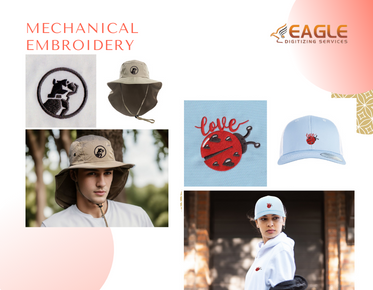Everything You Need to Know About Embroidering on Headwear
Embroidered caps have surged in popularity, transforming headwear into a canvas for creativity and self-expression. Once considered merely functional, caps now serve as fashionable statements, allowing individuals to showcase their personality and style. From streetwear enthusiasts to sports fans, everyone seems to be sporting these embellished accessories. The allure lies in their versatility—perfect for casual outings, outdoor activities, or even corporate branding. With brands and individuals alike recognizing the potential of embroidered designs, it’s no wonder these caps have become a hot commodity in fashion. If this post has aroused your curiosity about Embroidery Digitizing and you hope to gain more knowledge, reach out to us without hesitation.
Different Types of Caps and Hats Suitable for Embroidery
When diving into the world of cap embroidery, it’s essential to understand the myriad styles available. Snapbacks, characterized by their adjustable straps and flat brims, offer a modern aesthetic perfect for bold designs. Flexfit caps provide a snug, comfortable fit, making them ideal for intricate embroidery. Beanies, though typically associated with cold weather, have also found their way into the embroidery realm, allowing for unique, cozy designs. Each type of headwear presents distinct challenges and opportunities for creativity, and choosing a cap is a critical factor in your embroidery journey.
Understanding the Market: Customization Trends in Headwear
The trend of customization in headwear has skyrocketed in recent years, fueled by a desire for individuality. Consumers are increasingly seeking personalized products that reflect their values and tastes. Whether it’s through logos for sports teams, catchy phrases for brands, or unique artwork for personal use, the demand for embroidered caps is multifaceted. This growing market encourages both novices and seasoned embroiderers to experiment, innovate, and carve out their niche in the vibrant world of custom caps.
Essential Tools and Equipment for Embroidering Caps
The Right Embroidery Machine: Features to Look For
Choosing the right embroidery machine is pivotal for successful cap embroidery. Look for machines specifically designed for headwear, featuring a cap frame that accommodates various styles. Essential features include adjustable tension settings, a wide range of stitch options, and user-friendly interfaces. Additionally, machines with automatic thread cutting and programmable memory can streamline your workflow, allowing for more intricate designs without the hassle of manual adjustments.
Necessary Accessories: Hoops, Needles, and Threads Explained
Equipping yourself with the right accessories enhances your embroidery experience. Hoops are critical for securing your cap during the stitching process; consider investing in specialty cap hoops that provide a firm grip without distorting the fabric. Needles also play a vital role; choose those specifically designed for embroidery, typically featuring a larger eye to accommodate thicker threads. As for threads, opt for high-quality polyester or rayon options that boast durability and vibrant colors, ensuring your designs withstand the test of time.
Selecting the Best Stabilizers for Cap Embroidery
Stabilizers are your best friends when it comes to cap embroidery. They provide essential support to the fabric, preventing puckering and distortion during stitching. Choose between cut-away, tear-away, and water-soluble stabilizers based on your design's needs. Cut-away stabilizers offer the most support, ideal for dense designs, while tear-away stabilizers are great for simpler patterns. Water-soluble stabilizers work wonders for delicate fabrics or intricate details, dissolving away after stitching for a clean finish.
Choosing the Right Type of Cap for Embroidery
Understanding Different Cap Styles: Snapbacks, Flexfits, and Beanies
Understanding the unique characteristics of various cap styles is essential for successful embroidery. Snapbacks provide a flat, structured front, making them excellent for bold, graphical designs. Flexfit caps, on the other hand, offer a more fitted appearance, which can enhance the look of embroidered logos or subtle text. Beanies, while more challenging due to their stretchy nature, allow for unique designs that stand out, particularly when using embroidery techniques that add texture and depth.
Fabric Matters: How Material Affects Your Design
The material of your cap significantly impacts the embroidery process. Common fabrics include cotton, polyester, and blends, each with its unique characteristics. Cotton is breathable and easy to work with but may require special handling to prevent distortion. Polyester, known for its durability and vibrant color retention, is ideal for intricate designs. Consider the fabric’s weight and stretchability when selecting your design, as these factors influence how well your embroidery will hold up.
Sizing and Shape Considerations: Finding the Perfect Fit
The fit and shape of a cap can alter the placement and appearance of your embroidery. Ensure that you measure your caps accurately, as different styles can vary in size. Consider how the shape of the cap influences the design—curved brims may require more attention to placement than flat ones. Understanding these nuances will help you create designs that look polished and professional, ensuring that your embroidery complements the cap rather than overpowering it.
Designing Your Embroidery for Caps and Hats
Tips for Creating Eye-Catching Designs: Color and Contrast
Creating visually striking designs for caps involves a thoughtful balance of color and contrast. Bold colors tend to attract attention while contrasting shades can help your design pop against the fabric. Consider using color theory principles to choose complementary hues that enhance visibility. Incorporate gradients or textures to add depth, making your embroidery not just an image, but a dynamic visual experience.
The Importance of Digitizing: How It Impacts Your Design
Digitizing your design is a critical step in the embroidery process. It transforms your artwork into a format that an embroidery machine can read. Proper digitization ensures that your design translates accurately onto the cap, maintaining the integrity of your artwork. Pay attention to stitch types, density, and pathing, as these factors directly impact the outcome. Investing time in this process pays off, resulting in clean, professional-looking embroidery.
Understanding Placement: Where to Position Your Embroidery
Placement is key when it comes to cap embroidery. The front panel is the most common area, but don’t overlook the sides or back for additional branding or design elements. Consider how the cap will be worn—designs that are too low may become obscured, while those too high can feel awkward. Use templates to visualize your design's positioning and ensure it aligns with the cap's natural lines and structure.
Preparing Your Cap for Embroidery
Prepping Your Cap: Cleaning and Pressing for Best Results
Before starting the embroidery process, prepare your cap by cleaning and pressing it. Remove any dust or oils that could interfere with the stitching. Gently press the fabric to eliminate creases, ensuring a smooth surface for embroidery. This preparation not only improves the appearance of your final design but also helps your machine work more efficiently.
How to Properly Hoop a Cap: Techniques for Success
Properly hooping your cap is vital for achieving accurate and consistent embroidery. Begin by loosening the cap’s brim and placing it snugly within the hoop. Ensure that the fabric is taut but not stretched, as this can lead to distortion during stitching. Double-check the alignment before securing the hoop, and don’t hesitate to make adjustments to guarantee a perfect fit.
Adjusting Settings on Your Machine for Cap Embroidery
Adjusting your machine settings is crucial when transitioning from flat embroidery to cap embroidery. Pay attention to tension settings, as caps often require different thread tension than other fabrics. Ensure that your machine is equipped with the correct needle and that your design settings align with the specifications of the cap. Making these adjustments helps prevent common issues and ensures a smooth stitching process.
The Embroidery Process: Step by Step
Threading Your Machine: Getting Started Right
Getting started with the embroidery process begins with threading your machine correctly. Follow the manufacturer’s guidelines for threading, ensuring that both the upper and bobbin threads are in place. Double-check for any tangles or knots that could disrupt the stitching process. A well-threaded machine is the first step to achieving flawless embroidery.
The Stitching Process: Watching Your Design Come to Life
As your machine begins stitching, enjoy watching your design come to life. This is where the magic happens, and patience is key. Keep an eye on the process, ready to intervene if any issues arise. Take note of how the threads interact with the fabric, as this will inform any adjustments you may need to make in future projects.
Managing Thread Tension: Avoiding Common Pitfalls
Managing thread tension is one of the most critical aspects of the embroidery process. Inconsistent tension can lead to a variety of issues, such as thread breaks or uneven stitches. If you notice any problems, pause the machine and adjust the tension settings. Testing on scrap fabric can help you find the right balance before committing to your final design.
Troubleshooting Common Issues
Dealing with Needle Breakage: Causes and Solutions
Needle breakage is a common challenge faced during embroidery, and understanding its causes can help you avoid it. Issues such as using the wrong needle type, improper tension, or excessive speed can contribute to breaks. Always use a needle suited for your fabric and design, and make sure your machine’s settings are appropriate. If breakage occurs, assess the situation to identify the root cause and make necessary adjustments.
Fixing Thread Snags and Birdnesting: Tips for Smooth Stitching
Thread snags and birdnesting can derail your embroidery project, but they are often easily remedied. Ensure that your threads are properly loaded and that the bobbin is correctly inserted. If snags occur, check for any knots or tangles in the thread path. Birdnesting typically arises from poor thread tension; addressing this issue promptly will help maintain a smooth stitching experience.
How to Handle Fabric Damage During Embroidery
Fabric damage can happen, but knowing how to address it is essential. If you notice puckering or distortion, stop the machine immediately and assess the situation. Adjusting the hoop or tension may resolve the issue. In cases of significant damage, consider using appliqué techniques to cover imperfections creatively.
Post-Embroidery Care: Finishing Touches
Removing Stabilizer: Best Practices for a Clean Finish
Once the embroidery is complete, it’s time to remove the stabilizer. Follow best practices to ensure a clean finish: if using tear-away stabilizers, gently peel them away without pulling on the fabric. For cut-away stabilizers, trim closely to the stitching without cutting any threads. Proper removal enhances the professional look of your finished cap.
Trimming Threads and Final Adjustments: Achieving a Polished Look
Trimming excess threads is a vital step in the finishing process. Use sharp scissors to carefully snip any loose threads, ensuring a clean appearance. Additionally, take a moment to make any necessary adjustments to your design, whether it’s aligning elements or adding final touches. This attention to detail will elevate your cap's overall quality.
Ironing and Storing Your Caps: Maintaining Quality
Ironing your caps is crucial for maintaining their quality. Use a low heat setting to avoid damaging the fabric or embroidery. Store your caps in a cool, dry place, preferably in a way that preserves their shape. Proper care will keep your embroidered caps looking fresh and vibrant for years to come. For the excellent online digitizing design for embroidery, have no qualms about getting in touch with us.
The realm of custom cap embroidery is vast and full of potential. With every stitch, you have the chance to create something extraordinary, blending functionality with art. Embrace the challenges and joys of this craft, and let your imagination run wild as you explore the limitless possibilities of cap embroidery. Whether for personal use or a burgeoning business, the journey ahead is one of endless creativity and fulfillment.
.png)


